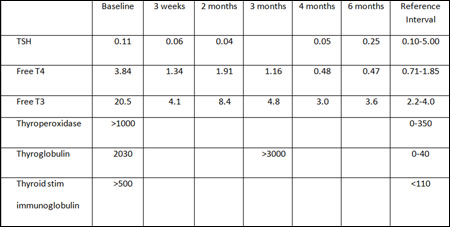How does your thyroid grow?
In September 2011, I presented the case of a 16-year-old girl who developed substantial thyroid gland growth after she had been treated with radioactive iodine therapy for initial management of severe hyperthyroidism. Every colleague from whom I solicited advice about this uncommon occurrence, as well as anything I could find in the published literature, pointed to marked elevations in thyroid antibodies as the primary cause for this sequence of events.
I am now caring for a 30-year-old woman who is 3 months into her therapy for Graves’ disease. She had been taking 20 mg of methimazole daily and also 20 mg of propranolol, but she did not think she was getting better and requested a referral to a surgeon. Some unrelated gynecologic issues developed and she put off her possible surgery while continuing to take her anti-thyroid medication. When I first saw her as a patient it was quickly apparent that her gland had enlarged in size quite substantially despite continued “appropriate” therapy.
Initially the left lobe of her thyroid gland was 5.0 × 1.7 × 1.8 cm and 5.1 × 1.9 × 2.3 cm on the right. At her most recent visit — 6 months after her initial diagnosis — the gland had dramatically enlarged to 6.8 × 2.7 × 3.2 cm on the left and 5.6 × 2.3 × 2.6 cm on the right. It was markedly enlarged but not tender and had no bruit or thrill. Deep tendon reflexes were brisk.
The table below details the changes in her thyroid function studies over the 6 months of oral therapy. Although thyroid-stimulating hormone (TSH) remained low and free T4 was also low, she had maintained free T3 levels close to the upper limit of the reference interval.

Source: Michael Kleerekoper, MD, MACE
Initially both T4 and T3 were elevated, and TSH was substantially suppressed. Over time, there was a progressive decline in all thyroid parameters except for the thyroglobulin antibody. Given the patient’s history, lab values, and the overall clinical picture, there was no need to continue to monitor the antibodies — surgical removal was the most obvious treatment option.
Lymphocytic infiltration of the thyroid is the result of the thyroid antibodies whether it be in patients with hypo- or hyperthyroidism. What I have not been able to ascertain is the mechanism linking these high antibody levels to the marked growth in thyroid size in the face of seemingly appropriate oral therapy.
It also makes me wonder whether thyroid antibodies should/must be measured in all newly diagnosed patients with hypo- or hyperthyroidism. Would that alter management?
Any advice from thyroid experts would be most welcome.
